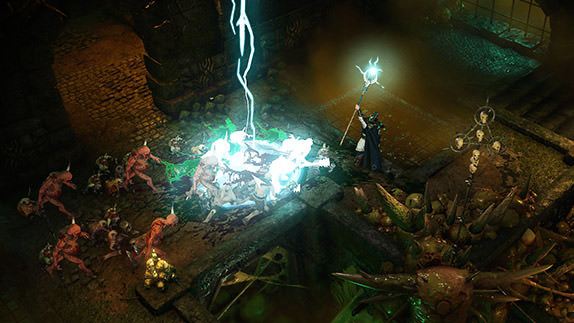Dragon Age: Inquisition Review

 By Marcus Jones
Posted on December 9, 2014
By Marcus Jones
Posted on December 9, 2014
Dragon Age: Inquisition is set around the conclusion to a story originating from Dragon Age II. While I will not spoil any details, a major player from the previous game returns regardless of player choices. It sets up this massive game, as you must explore the whole of Thedas to prevent the Veil from ripping the world to pieces, leaving nothing but a wasteland of death and demons. BioWare’s success in creating these epics and including their believable characters, fantastic situations, and heroic stories once again shines through with this new addition to the series.
In terms of scope, Dragon Age: Inquisition is single-handedly the largest DA game to date. It’s certainly a massive improvement from the size of Dragon Age II and its repetitive dungeons. Expect to visit multiple locations throughout the world, all large, sprawling areas in their own right. Each area has its own set of enemies, quests, and unique facets that you can explore. One area, The Emerald Graves, is a massive set of woods full of ancient Elvish ruins, while the Western Expanse is a series of deserts, canyons, and caves full of giant spiders. The diversity of the game’s areas is a fantastic improvement over the last two games and since each area has a seemingly endless number of quests, be ready to stay busy. It doesn’t hurt either that the game’s huge vistas are beautiful. I’ve spent my fair share of time just admiring the landscapes and amazing views within the game, especially of the tear in the sky. The game does not disappoint for those looking for an amazingly good-looking experience on top of good story and gameplay.
This happens to be both a blessing and curse in disguise for Inquisition. The game’s variety of questions boil down to a number of fun and exciting ones to the mundane and “here’s something for you to do” type quests. One minute you might be hunting down apostate mages and the next running from point A to point B to light a candle on a grave. While I personally do not mind these filler quests when they come up, they can become a drag for some players, especially with the “rewards.”
Even with the filler quests, Inquisition does not properly open up until the start of Act 2. It’s all fine and dandy throughout the early part of the game, but even with the massiveness of The Hinterlands, it quickly becomes boring and a change of scenery is needed. Early on, players utilize Haven as their command base for the fledgling Inquisition. This is where you’ll be able to meet with your party members, send Inquisition forces out on missions, and generally manage the Inquisition as a whole. While it’s not a bad place, Act 2 places players in Skyhold, a massive fortress within the mountains. It’s here the Inquisition truly starts to take form as here players can manage fortress upgrades, meet with various members of your forces, and lay down judgment as the Inquisitor. Until this point in the game, it felt a little constricted in scope and I wondered when the true gameplay would begin. Once it does though,Inquisition opens up and does so in rapid fashion.
Everything quickly goes from small-scale to massive in what seems like twenty minutes. The War Council, the place where Inquisition forces are sent in missions, goes from having a one or two points of interest to over two dozen. Sending out troops requires the power earned from completing quests. Completing these missions opens up new areas on the map, additional upgrades for Skyhold, and potential new agents for the Inquisition. Between the agents and completing quests, eventually you earn Influence within the game and the Inquisition ranks up, allowing the possibility of purchasing new perks that affect gameplay. These range from increasing the inventory limit to opening up new schematics for crafting. These perks all help, so it’s worth taking the time and ensuring the correct ones are picked.
Speaking of crafting, however, it adds an entirely new level to the game. Players can craft both weapons and armor with resources found in the game, but also additional pieces that can upgrade them further. There’s even a “Masterwork” level of crafting that adds additional bonuses or potentially upgrades an item even further. I lucked out once and managed to score a 10% boost to a weapon’s stats, making it the strongest weapon in my arsenal. The resources add an even further level to the process. There are multiple tiers of quality and higher quality materials result in better item statistics.
Taking notes from their mistakes in the last game, BioWare changed up the gameplay of Inquisition considerably. No longer will you need to tap A to continue attacking enemies – now it’s done by just holding down the right trigger. While it’s not like the automatic combat found in Dragon Age: Origins, it’s a nice change of pace. It keeps players engaged as they still must hit buttons to use special abilities. A huge improvement to Inquisition is the new Tactical View. This pauses the game and switches the camera to an old-schoolIcewind Dale view, letting players issue commands to their party and look at information of enemies. It plays out like the classic BioWare RPGs, letting you take your time in tackling a fight.
The other new piece to the Dragon Age mythos is the inclusion of online multiplayer. Built similarly to Mass Effect 3, players will create an online avatar based on pre-built classes. Each of these are based on the previous games’ specialization classes. Once that’s done, together up to four players run through dungeons in an attempt to reach the end and kill the main boss. It’s not a bad experience and the multiplayer aspect even uses the crafting and inventory aspect from the single-player experience. It’s just a major pain to try and unlock the additional classes as their armor must either be crafted or found and neither is a simple task.
Simply Put
Dragon Age: Inquisition is perhaps one of the best RPGs I have ever played. It combines a number of excellent elements and stuffs them into a huge game. It’s got a little something for everyone and enough meat to the game that it’ll keep them going. Fans of the series will not be disappointed and those wanting to jump in will be awed.
Note: Dragon Age: Inquisition was reviewed on Xbox One. A physical copy of the game was purchased by SelectButton.




